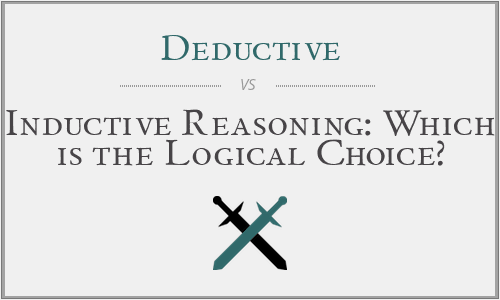
Are you a logical person?
Do you trust your gut?
Deductive and Inductive Reasoning
In the branch of philosophy called logic, we study the laws of thought and correct reasoning. Deductive and inductive reasoning are two valid processes of logic that we use every day to help us make decisions.
Both deductive and inductive reasoning begin with basic premises from which logical conclusions are inferred.
These processes of deductive and inductive reasoning are part of the “scientific method” that is used by used by scientists, mathematicians, and philosophers to prove the validity of their hypotheses.
What is Deductive Reasoning?
Deductive reasoning is often referred to as top-down logic because its conclusions are made by applying wide general ideas to specific, narrow conclusions.
The process of deductive reasoning starts from a premise that is based on facts or on known information. From these facts, a logical conclusion is reached.
• If the reasoning process is based on a sound premise, then this deductive argument and its conclusions are considered valid.
• If the reasoning process is based on an unsound premise, then the deductive argument and its conclusions are considered invalid.
1. All dogs are animals.
2. Spot is a dog.
3. Therefore, Spot is an animal
This example is valid, sound deductive reasoning. The two premises of this example are sound: it is true that all dogs are animals, and it is also true that Spot is a dog. From this valid basis, we can make a valid conclusion; that is, we can safely deduce that Spot is an animal.
1. All people have ten toes.
2. Ray is a person.
3. Therefore, Ray has ten toes.
Although this argument is valid and logical, the premise that “all people have ten toes” in not correct: some people are born with eleven toes. This is therefore an example of valid but unsound deductive reasoning.
What is Inductive Reasoning?
Inductive reasoning (induction) is also called bottom-up logic because it starts with specific, narrow information and forms general conclusions.
We would be using induction if we observe specific behavior and then make a generalization based on that specific example.
For example:
You might observe that your colleague greets another colleague by giving her a hug. You might induce that she greets all colleagues that way.
For example:
Tennis balls are placed in three groups, where the first group has three balls, the second group has four balls, and the third group has five balls. Using inductive reasoning, how many balls would be in the next group? By observing the pattern of three, four, five, it can be induced that the next group will have six balls in it.
• Strong inductive logic is convincing because it is based on a true premise. If the logic is indeed strong and it is based on a true premise, then it is a sound argument, and its conclusions are likely to be true.
• Weak inductive logic is always unconvincing because it is based on a premise that may or may not be true. If the logic is weak and it is based on an untrue premise, then it is called an unsound argument, and its conclusions are likely to be untrue.
• Interestingly, when using inductive logic, the premise can be true, the reasoning can be strong, but the conclusion can still be incorrect.
For example:
1. Most men are brown-eyed.
2. John is a man.
3. Therefore, John must be brown-eyed.
The premise of this statement is: “Most men are brown-eyed.” This premise is true. The logic that follows is strong.
However, because we do not know the actual number of brown-eyed men in the world, the process of inductive reasoning does not ensure that the conclusion will be valid.
Inductive reasoning can also be called “hypothesis construction”. This is because its conclusions are based on predictions of the future.
For example:
You see a young child take a toy from his friend. You unconsciously predict that he is a child who takes toys from other children. This inductive reasoning is not based in fact and, as such, you have not reached a reliable conclusion.
Humans also tend to make conclusions based on information that is available through their senses, and they tend to confirm rather than disprove an accepted hypothesis.
For example:
It took many centuries to change the belief that the world was flat or to disprove the hypothesis that the sun revolved around the earth, even though there was ample proof to the contrary. We simply used inductive reasoning to jump to conclusions, and then we stubbornly stuck to what we believed.
Conclusion
We use different types of logic to make conclusions and to solve problems in our daily lives. At times, these conclusions are accurate; other times, these conclusions prove unbelievably incorrect.
Deductive reasoning has a higher accuracy rate than inductive reasoning. But it is harder to implement in real life. It is based on fact finding and truth, and it often needs a laboratory to satisfy its conditions.
It does not leave much room for imagination or intuition.
Inductive reasoning is often based on emotions and can be used to make snap judgements and quick inferences. Inductive reasoning goes well with our intuition.
It may or may not always give you an accurate, predictable outcome, but it is the way that we most often make decisions.




Have a discussion about this article with the community:
Report Comment
We're doing our best to make sure our content is useful, accurate and safe.
If by any chance you spot an inappropriate comment while navigating through our website please use this form to let us know, and we'll take care of it shortly.
Attachment
You need to be logged in to favorite.
Log In